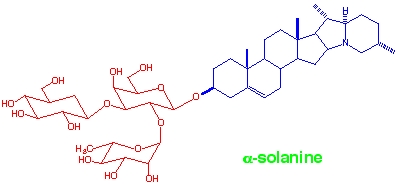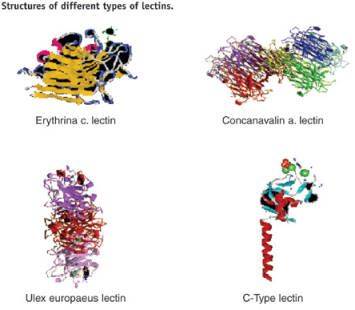Alkaloids and lectins: toxic substances
Solanine
Solanine is a glycoalkaloid poison found in species of the nightshade family ( Solanaceae ), such as the potato ( Solanum tuberosum ) and the tomato ( Solanum lycopersicum ). It can occur naturally in any part of the plant, including the leaves, fruit, and tubers. Solanine has fungicidal and pesticidal properties, and it is one of the plant's natural defenses. Solanine was first isolated in 1820 from the berries of the European black nightshade ( Solanum nigrum ), after which it was named. α-solanine ( C 45 H 73 NO 15 ) and α-chaconine constitute 95% of all glycoalkaloids (GAs), and they’re also called saponins . Both are glycosylated (trisaccharide) derivatives of the aglycone solanidina, a steroid alkaloid. GAs appear to have two toxic actions, one on cell membranes and another on acetylcholinesterase.

First, the toxicity on membranes leads to cell disruption, thought to be caused by the formation of destabilising complexes of the lipophilic moiety of the GAs with cholesterol in membranes. So it alters intestinal permeability and causes gastrointestinal disturbances like vomiting, diarrhoea, abdominal pain. These kinds of poisoning should be underdiagnosed because the symptoms are similar to those of other common gastro-intestinal aliments. For humans with chronic inflammatory bowel disease, exposure to higher GAs concentrations might cause persistence or aggravation of their illness.

Secondly, GAs inhibit the enzyme acetylcholinesterase, blocking nerve pulse transmission, thereby affecting the nervous system directly, with symptoms such as sweating, vomiting, diarrhoea and bronchospasm. Severe poisoning may lead to serious adverse events, like paralysis, respiratory insufficiency, cardiac failure and coma. Cases of lethal poisoning have been reported at estimated doses greater than 3 mg GAs/kg of body weight. Furthermore, the inhibition of the enzyme may also alter the kinetics of drugs, e.g., neuromuscular blocking agents.
Home cooking, frying, baking, microwaving will not destroy GAs; they are fairly heat-stable. Their melting points, at which they start decomposing, are in the range of 190-285°C.
Two experimental studies measured chaconine and solanine’s serum concentrations after administration of GAs solution or mashed potatoes in volunteers. Both studies revealed that the peak concentrations were reached after approximatively 4-8 hours, and that none of the serum glycoalkaloid concentrations returned to baseline within 24 h post-dose. Both chaconine and solanine have long half-lives, on average 44 and 21h, respectively. This implies that daily consumption of potato products may cause accumulation of glycoalkaloids, which may lead to adverse health effects.
Potato alkaloids and adverse effects in humans: an ascending dose study, 2004
Solanine poisoning: symptoms
Solanine poisoning is primarily displayed by gastrointestinal and neurological disorders. Symptoms include nausea, diarrhea, vomiting, stomach cramps, burning of the throat, cardiac dysrhythmia, nightmare, headache and dizziness. In more severe cases, hallucinations, loss of sensation, paralysis, fever, jaundice, dilated pupils, hypothermia and death have been reported. Most potato poisoning victims recover fully, although fatalities are known, especially when victims are undernourished or do not receive suitable treatment.
Symptoms usually occur 8 to 12 hours after ingestion, but may occur as rapidly as 30 minutes after eating high-solanine foods.
The lowest dose to cause symptoms of nausea is about 25 mg solanine for adults, a life-threatening dose for a regular-weight adult ranges about 400 mg solanine.
Benefits
α-chaconine and α-solanine have anticarcinogenic effects on human cervical, liver, lymphoma, stomach cancer cells and normal liver cells.
Anticarcinogenic Effects of Glycoalkaloids from Potatoes against Human Cervical, Liver, Lymphoma, and Stomach Cancer Cells, 2005
Mechanism of action
The toxic mechanism of solanine is caused by the chemical's interaction with mitochondrial membranes. Experiments show that solanine exposure opens the potassium channels of mitochondria, decreasing their membrane potential. This in turn leads to Ca2+ being transported from the mitochondria into the cytoplasm, and it is this increased concentration of Ca2+ in the cytoplasm that triggers cell damage and apoptosis.
Correlation with birth defects
Solanum glycoalkaloids can be teratogenic. Some studies show a correlation between the consumption of potatoes suffering from late blight (a disease which increases solanine and other glycoalkaloid levels) and the incidence of congenital spina bifida in humans. However, other studies have shown no correlation between potato consumption and the incidence of birth defects.
Solanine in potatoes
Potatoes naturally produce solanine and chaconine, as a defense mechanism against insects, disease, and predators. Potato leaves, stems and shoots are naturally high in glycoalkaloids.
When potato tubers are exposed to light, they turn green and increase glycoalkaloid production. This helps prevent the uncovered tuber from being eaten. The green colour is from chlorophyll, and is itself harmless. However, it is an indication that increased level of solanine and chaconine may be present.
Some plants’ diseases and mechanical damage can dramatically increase the levels of glycoalkaloids present in potatoes as a natural reaction of the plant.
The alkaloid is present in the tuber at low doses (less than 10 mg per 100 g) and concentrated mainly in the skin, which is then best to remove. When the concentration is higher, as in some varieties, the result is a bitter taste of the tuber. The tubers green color due to sun exposure, contain a substantial amount of solanine, with values that may even get to 100 mg/100 g. The potatoes should be stored in dark places. The United States National Institutes of Health ’s information on solanine says to never eat potatoes that are green below the skin.
The solanine is not eliminated by cooking, because it is degraded only at temperatures above 243 ° C. The solanine becomes dangerous when taken in quantities exceeding 20 milligrams per 100 grams of fresh product, but we need not take the alarm. In fact, so that it manifests the beginning of intoxication, it is necessary that a person weighing 70 kg eat in one meal 2 kg of potatoes.
The concentration of the substance depends not only on farming techniques, but also on the preservation of the tubers after harvest. It also depends on the variety of potato used, at the same conditions of soil and crop averages.
According to an experimental research followed for two years by Linda Sacchetti on behalf of the Consortium of Quarantine, in collaboration with the University of Siena (Prof. Nadia Marchettini) at the chemical laboratory of the Chambers of Commerce of Albenga, solanine is present in higher concentration when the potatoes :
• are harvested immature with the plant still not completely dry;
• have a green color on the skin due to exposure to sunlight;
• have shoots;
• are overripe, ie start to wilt and show a wrinkled skin;
• are damaged or diseased .
Potatoes should be eaten no later than five months after collection, if kept in a cool and dark place. This research has also shown that:
- the same variety grown by the same farmer in the same area, using organic methods, presents an amount of solanine lower of 30% compared to that grown by conventional method;
- the method of cooking influences the percentage of ingested solanine. Tests were performed with and without peel and cook the potatoes in water, steaming, frying, in oven and microwave. The percentage of solanine in potatoes boiled, in their skins, in water was 170 times greater than the percentage found in baked potatoes without the skin in a pressure cooker. Deep frying potatoes at 170°C (338°F) is known to effectively lower glycoalkaloid levels (because they move into the frying fat), as does boiling (because solanine is water soluble), while microwaving is only somewhat effective, and freeze drying or dehydration has little effect.
These conclusions are confirmed by another study conduced by Czech University of Life Sciences of Prague: Effect of peeling and three cooking methods on the content of selected phytochemicals in potato tubers with various colour of flesh, 2013

In the 70s, Solanine poisoning affected 78 school boys in Britain. Due to immediate and effective treatments, no one died.
Although cooked and peeled potatoes’ content in solanine and lectine is reduced, nutrients like vitamin B5 are lost with the cooking.
Experimental studies
Comparative coexpression analysis between tomato and potato coupled with chemical profiling revealed an array of 10 genes that partake in SGA (Steroidal glycoalkaloids, such as α-solanine) biosynthesis. Six of them exist as a cluster on chromosome 7, whereas an additional two are adjacent in a duplicated genomic region on chromosome 12. Silencing GLYCOALKALOID METABOLISM 4 is a means for removal of unsafe, antinutritional substances.
Biosynthesis of antinutritional alkaloids in solanaceous crops is mediated by clustered genes, 2013
The maximum cytotoxic effect of alkaloids α-solanine and α-chaconine on C6 rat glioma cells was observed at a ratio of 1:1 (α-solanine:α-chaconine) at micromolar concentrations. The rapid damage of plasma membrane causes the lethal disorder of metabolism. It was so demonstrated the synergistic cytotoxicity between the two compounds.
However, solanine has a low rate of absorption into the bloodstream, is hydrolyzed intestinally to a less toxic and poorly absorbed product, and has a rapid fecal and urinary excretion rate. It is noteworthy that potatoes also contain poisonous compounds like oxalic acid, arsenic, tannins, and nitrate.
A Swedish trial has confirmed that in potatoes shoots the entire cholesterol molecule is converted to SGA; except for two hydrogen atoms, that were released during formation of the SGA nitrogen-containing ring system. It was so demonstrated that cholesterol is a specific SGA precursor in potatoes.
Wounding and light exposure, but not heat, increased tuber glycoalkaloid (α-chaconine and α-solanine) levels. The total calystegine (another alkaloid) level, instead, was not affected by wounding or light exposure. So it was demonstrated that the biosynthesis of glycoalkaloids and calystegines occurs independently of each other.
Glycoalkaloid and calystegine levels in table potato cultivars subjected to wounding, light, and heat treatments, 2013
Lectins
The potato also contains lectins, but these are destroyed by cooking. Lectins are proteins capable of binding reversibly to mono-or oligosaccharides. This property allows lectins to agglutinate human red blood cells and likely to disrupt the proper functioning of the digestive system of insects that feed on the plant, thus constituting a defensive role of the plant against insects. In plants, they are distributed in various families and hence ingested daily in appreciable amounts by both humans and animals. Lectins are able to survive digestion by the gastrointestinal tract of consumers. This allows the lectins to bind to membrane glycosyl groups of the cells lining the digestive tract. As a result of this interaction a series of harmful local and systemic reactions are triggered placing this class of molecules as antinutritive and/or toxic substances. Locally, they can affect the turnover and loss of gut epithelial cells, damage the luminal membranes of the epithelium, interfere with nutrient digestion and absorption, stimulate shifts in the bacterial flora and modulate the immune state of the digestive tract. Systemically, they can disrupt lipid, carbohydrate and protein metabolism, promote enlargement and/or atrophy of key internal organs and tissues and alter the hormonal and immunological status. At high intakes, lectins can seriously threaten the growth and health of consuming animals. They are also detrimental to numerous insect pests of crop plants.
